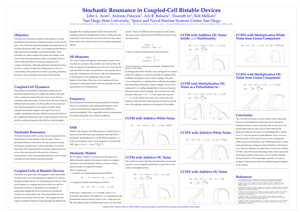 |
||||||||
 |
 |
 |
 |
 |
| Intelligent Sensor Networks: Towards of Theory of Stochastic Resonance in Multi-Stable Systems | ||
|
A large class of dynamic sensors exhibit nonlinear
input-output characteristics, often corresponding to a bistable
potential energy function. Examples include: magnetic field sensors,
e.g., fluxgate sensors, ferroelectric sensors, and mechanical sensors,
e.g., acoustic transducers made with piezoelectric materials. Many
of these sensors have assisted mankind in analyzing and controlling
thousands of functions for many decades. Computer memory has increased
over many years through the use of magnetic sensors embedded in
storage devices. Airplanes fly with higher safety standards because
of the high reliability of noncontact switching with magnetic sensors.
As new technologies emerge, however, more powerful and more efficient
sensors are required. In response to this need, we present preliminary
results which demonstrate that higher sensitivity, lower power-consumption,
and reduced costs, can all be achieved
| ||
through an integrative approach that combines a novel
Intelligent Sensor Network (ISN) network architecture with a new sensing
technique, the Residence Time Detection (RTD). By intelligent, we
mean the following. We treat each sensor as a nonlinear dynamical
system of the form dx/dt = -grad(U(x)), where x(t) is the state variable
of the device, e.g., magnetization state, and U is the bistable potential
function. Then the fundamental idea is to exploit the phenomenon of
coupling-induced oscillations and the nonlinear characteristics of
magnetic materials so that the ISN network can, intelligently, produce
its own self-biasing signal and, simultaneously, achieve better sensitivity. |
||
| • Other Abstracts • | ||
